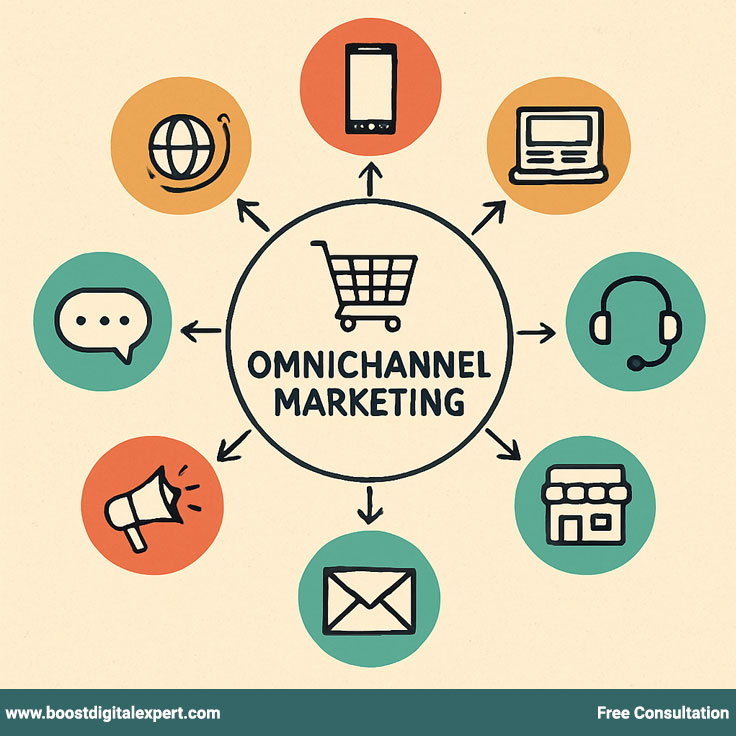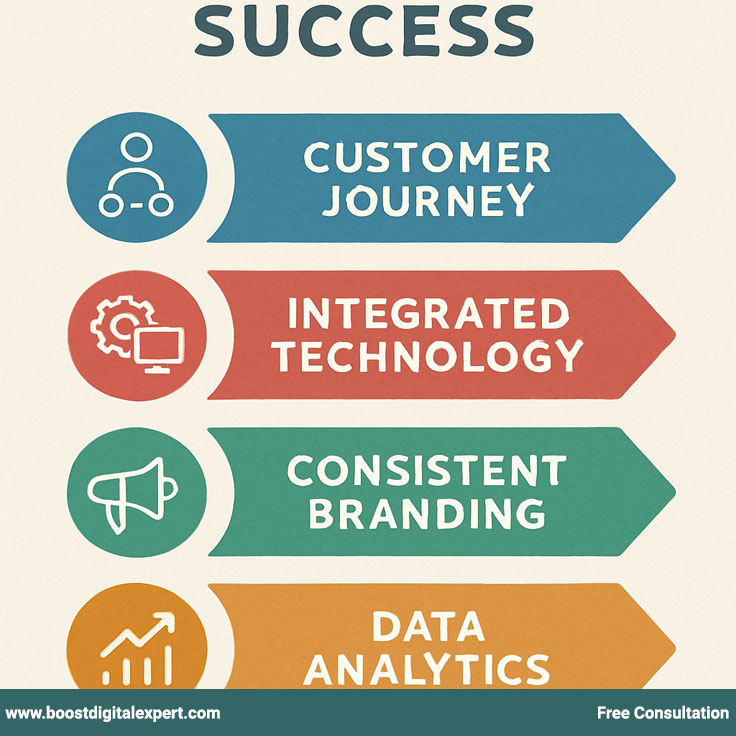In today’s fast-paced digital world, consumers interact with brands across multiple platforms.
Whether it’s shopping online, visiting a store, or engaging through social media, customers expect
a seamless experience. Enter omnichannel marketing, a strategy that integrates various channels
to create a unified customer journey. Let’s dive into this approach and understand why it’s
essential for your business.
Omnichannel marketing is a strategy that ensures customers have a consistent and integrated
experience across all platforms and devices. Unlike multichannel marketing, which involves using
multiple channels independently, omnichannel marketing connects them to provide a cohesive
journey. This means a customer’s experience on your website should align with their experience
on social media, in-store, and through email communications.
The Core Principles of
Omnichannel Marketing?

Omnichannel digital marketing revolves around creating a harmonious customer experience.
This involves understanding that every interaction, regardless of the platform, should feel
like a natural extension of the previous touchpoint. This continuity is crucial in building
trust and loyalty with your audience.
The key difference between omnichannel and multichannel marketing lies in integration.
While multichannel marketing offers customers various ways to engage with a brand, these
channels often operate in silos. Omnichannel marketing, on the other hand, seamlessly
integrates these channels, ensuring that the customer journey is uninterrupted and cohesive.
Real World Examples of
Omnichannel Success?
Many businesses have successfully implemented omnichannel strategies. Companies
like Starbucks and Disney have created seamless experiences by integrating online
and offline channels. Starbucks, for example, allows customers to order
through their mobile app and pick up in-store, creating a unified shopping
experience. Disney’s MyMagic+ program integrates its website, mobile app,
and theme park experiences into a single, comprehensive journey for visitors.
The Importance of Omni-Channel Marketing?

Enhanced Customer Experience
With an omnichannel approach, customers receive a seamless experience, which boosts
satisfaction and loyalty. For instance, if a customer adds a product to their cart on your
mobile app, they should find it in their cart when they switch to a desktop. This consistency
reduces friction and makes the purchasing process smoother.
Increased Reach and Engagement
By being present on multiple platforms, you can engage with a broader audience. Omnichannel
strategies ensure that whether a customer is on social media, reading emails, or shopping
in-store, they receive consistent messaging. This consistency helps reinforce brand identity
and encourages customer interaction across various touchpoints.
Improved Data Collection and Insights
Integrated channels allow businesses to gather comprehensive data on customer behavior.
This data can be used to refine marketing strategies and improve personalization.
By understanding customer preferences and behaviors, you can tailor your
marketing efforts to better meet their needs, ultimately driving higher conversion rates.
Steps to Implement
Omni-channel Marketing?

1. Understand Your Customer Journey
To successfully implement omnichannel marketing, you first need to understand your customer
journey. Map out how customers interact with your brand from discovery to purchase and
beyond. Identify key touchpoints and understand the role each channel plays in this journey.
Mapping Customer Interactions
Start by creating a detailed map of your customer journey. This involves identifying every possible
interaction point, from initial brand awareness to post-purchase follow-up. Understanding these
interactions helps you pinpoint opportunities to enhance the customer experience.
Analyzing Customer Pain Points
Once you’ve mapped the customer journey, analyze each touchpoint to identify potential
pain points. These are areas where customers may experience frustration or confusion.
By addressing these issues, you can improve the overall customer experience and foster loyalty.
Utilizing Customer Feedback
Customer feedback is invaluable in understanding the effectiveness of your current strategy.
Regularly solicit feedback through surveys or direct communication, and use this information
to refine your omnichannel approach. Listening to your customers’ voices can help you make
informed adjustments to your strategy.
2. Align Your Channels
Ensure all your marketing channels are aligned and work together. This means your website,
social media, email, and physical stores should share consistent messaging and branding.
Use the same tone, style, and information across all platforms.
Consistent Branding
Consistent branding is crucial in omnichannel marketing. Every platform should reflect the same brand image, using similar colors, logos, and messaging. This consistency strengthens brand recognition and trust among customers.
Unified Communication Strategy
Develop a communication strategy that unifies messaging across channels. Whether a customer
reads an email, visits your website, or interacts on social media, the message should be consistent
and coherent. This unified approach reinforces your brand’s message and values.
Cross-Channel Promotions
Leverage cross-channel promotions to create a more integrated customer experience.
For example, use social media to promote exclusive in-store events or offer online
discounts that can be redeemed in physical locations. These promotions encourage
customers to engage with your brand across multiple touchpoints.
3. Use the Right Tools
Invest in tools that help integrate your channels. Customer Relationship
Management (CRM) systems, marketing automation platforms, and analytics
tools are essential. They allow you to track customer interactions, gather insights,
and automate processes.
Choosing the Right CRM System
Select a CRM system that aligns with your business needs. A robust CRM can help you manage
customer data, track interactions, and personalize communication. This personalization is key
to enhancing the customer experience and increasing engagement.
Implementing Marketing Automation
Marketing automation tools streamline processes and improve efficiency. These tools can automate
repetitive tasks, such as sending follow-up emails or posting on social media, freeing up time for more
strategic initiatives. Automation also ensures timely and consistent communication with customers.
Leveraging Analytics Tools
Analytics tools provide valuable insights into customer behavior and campaign performance.
Use these tools to track key metrics and identify trends, allowing you to make data-driven
decisions. This data-driven approach helps you refine your strategy for better results.
4. Personalize the Experience
Use the data you collect to personalize customer interactions. Tailor your messaging and
offers based on customer preferences and behaviors. For example, if a customer frequently
buys sports gear, send them promotions related to fitness products.
Segmentation and Targeting
Segment your audience based on demographics, behaviors, and preferences. This segmentation
allows for more targeted marketing efforts, ensuring that the right message reaches the right
audience at the right time. Targeted campaigns are more likely to resonate with customers
and drive conversions.
Dynamic Content Personalization
Utilize dynamic content to personalize the customer experience. Dynamic content changes
based on user behavior, ensuring that each interaction is relevant and engaging. This
personalization can significantly enhance customer satisfaction and loyalty.
Personalized Offers and Recommendations
Offer personalized promotions and recommendations based on customer data. By
understanding individual preferences, you can provide offers that are more likely to
appeal to each customer. Personalized recommendations enhance the shopping
experience and increase the likelihood of repeat purchases.
5. Test and Optimize
Omnichannel marketing requires continuous testing and optimization. Use A/B testing
to find out what works best and adjust your strategies accordingly. Regularly review your
data to identify trends and areas for improvement.
Conducting A/B Tests
A/B testing is a powerful tool for optimizing your marketing efforts. Test different elements
of your campaigns, such as subject lines, visuals, and calls-to-action, to determine what
resonates best with your audience. This iterative process helps refine your strategy for
maximum impact.
Analyzing Campaign Performance
Regularly analyze the performance of your marketing campaigns. Use metrics such as
engagement rates, conversion rates, and customer feedback to assess effectiveness.
This analysis provides insights into what’s working and where adjustments are needed.
Iterative Improvement
Omnichannel marketing is an ongoing process that requires continuous improvement.
Use insights gained from testing and analysis to make informed adjustments to your
strategy. This iterative approach ensures that your marketing efforts remain effective
and aligned with customer needs.
Conclusion
Omnichannel marketing is not just a trend, it’s a necessity in today’s digital landscape.
By providing a seamless and integrated experience, businesses can enhance customer
satisfaction, increase reach, and gain valuable insights. Whether you handle it in-house or partner with a digital marketing agency, the key is to start integrating your channels
and focusing on the customer journey. With the right strategy and tools, you can transform your
marketing efforts and drive business growth.
The goal is to make every interaction with your brand a positive one, regardless of the channel
or medium. Start your omnichannel journey today and watch your business thrive. By prioritizing
the customer experience and leveraging the power of integrated marketing, you can build lasting
relationships and achieve sustainable success in the digital age. Consult Now!









Leave a Reply